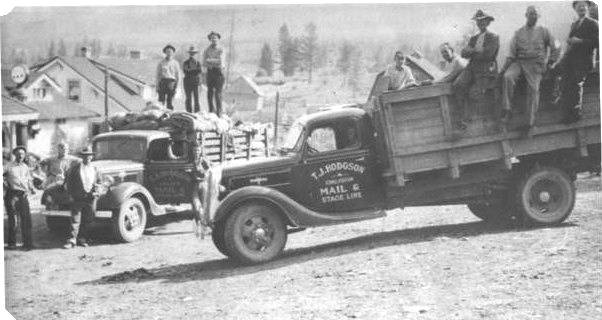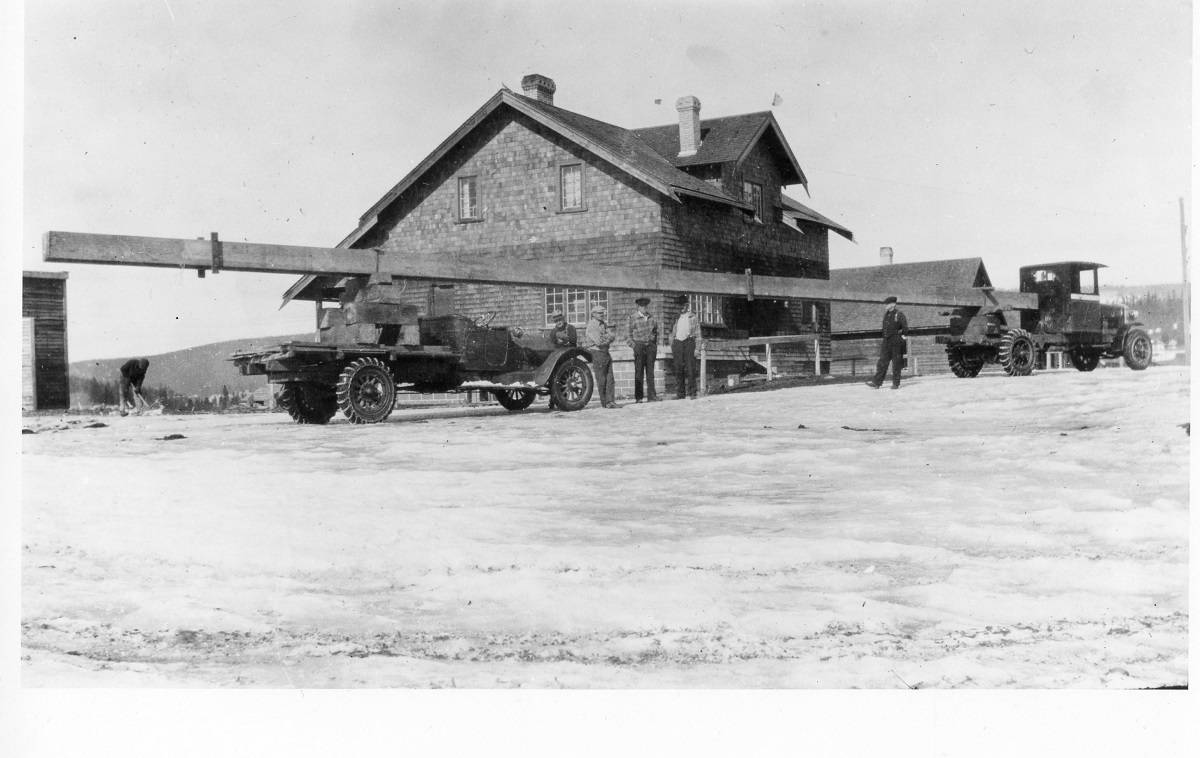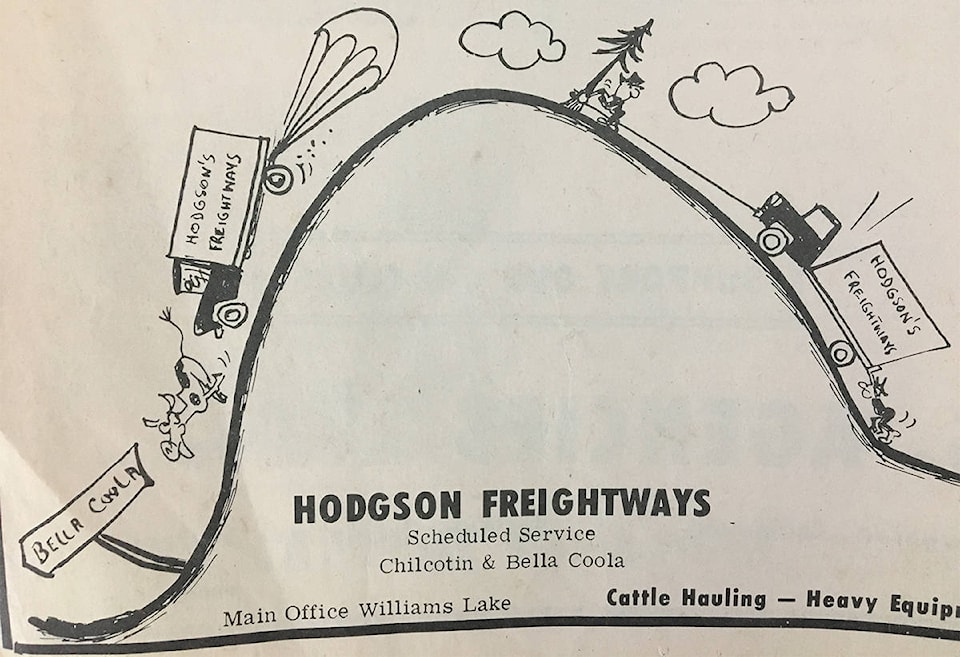The stretch of highway from Williams Lake to Bella Coola is home to many stories.
Everyone and their border collie has a tale about daring the Bella Coola Hill without winter tires on (or giving up and skiing down), blowing a tire on the side of the highway with no cell service and a long walk for help, or stopping in for ice cream on a hot day at the former Lee’s Corner store.
Perhaps no one has as many stories as the Hodgsons, a family who has been driving Highway 20 since before Highway 20 existed. Tom Hodgson still drives the road today, though unlike his grandfather, the first Tommy Hodgson, he doesn’t use a horse and wagon. Tom now drives a low bed trailer for Tsi Del Del Enterprises, after hauling logs through the Chilcotin for much of his life.
It’s a trade he comes by honestly. Tom learned to drive on his father’s knee as a child.
When the first Tommy Hodgson arrived in the Cariboo in 1912 he took on the weekly mail run to the Chilcotin. At the time, Tommy used a team of horses and a sleigh in the winter - the road wasn’t plowed until well into the 1930s. In 1915 he bought a passenger Cadillac, but Tommy was known to haul anything and everything — mail, groceries, and people.
While parts of the road detour from the route Tommy took — Hodgson Road is the original Highway 20, which in its early days was called the Chilcotin Road — others are very much the same, though at the time Tommy drove, parts of the road could barely be considered a road
He’d leave Williams Lake weekly, heading to Riske Creek or Redstone until the 1920s when he picked up the mail contract to Tatla Lake and Kleena Kleene, making the Chilcotin line the longest mail run in the British Empire.
In 1929, it took two days to drive from Williams Lake to Kleena Kleene, though sometimes, possibly more often than not, the road was longer.
If weather wasn’t the issue, then mechanical parts were, but the trucks were a lifeline to the Cariboo. The Hodgson trucks even carried massive bridge timbers to Hanceville, which the drivers mounted one-at-a-time on two trucks, navigating the hairpin turns of the Sheep creek hill.
Tommy’s sons, Cookie, Jack and Wilfred took over from Tommy, when he suffered a series of strokes during the Second World War. At the time, Tom says his father, Wilfred, was driving a low bed on the front lines.
They renamed Chilcotin Mail and Express to the Hodgson Brothers, and carried on trucking for another 30 years.
In 1962, when Tom was only eight, the Hodgson brothers sold the company, though even today Hodgson Freightways operates out of Bella Coola.
Tom said he’s a little sad the company was sold — “it would have been kind of neat, but at the time wasn’t making much money.”
Still, he’s fairly matter-of-fact, about it: he shrugs when he mentions the sale.
Highway 20 is a lot less wild than it was in the days of his father and grandfather — Tom can get from Anahim Lake to town and back in less than a day.
There’s more than one story told of the Hodgsons breaking down or almost slipping off the highway in a particularly risky area.
Tom tells of one moment when his dad Wilfred, with a new puppy in the truck, broke down 15 miles from Tatla Lake. At the time, during the winter, the road was much smoother if they drove on the ice.
“It was 40 below and he was walking from his truck to Tatla and he said he could see the lights way down at the end,” said Tom.
“The wolves were howling and this little dog kept trying to trip him up all the way.”
The next morning on the trek back, Wilfred could see the prints of the wolves following them in the snow.
As previously mentioned, Tom learned to drive on his fathers lap, and he said it was not unheard of that when his parents had had a couple drinks in town for Wilfred to head up the hill and then switch driving seats with Tom to have him drive home to Riske Creek.
“The stories he used to tell — he used to show me ditches, ‘Oh yeah, I slept next to that ditch’ because he’d broken down.”
If you pry enough, Tom has a few stories of his own.
The first time driving a truck was after him and his father bought one. Tom had been working on a skidder with a friend at the time.
“Dad always drove so I wanted to be a trucker,” he said, adding that he wasn’t a fan of the skidder. “I saw trucks coming and wanted to do that.”
His first time in a truck? Well, just after they bought it.
“My dad said, ‘Oh, you should go do the test and then we’ll drive to Bella Coola on the gravel. Anyways, I failed the test.The guy at the government building said ‘turn around and go out the street.’ I missed two shifts before I got out of the parking lot.”
It didn’t seem to matter much.
“I went to work in Bella Coola for three months and then came back and passed my test.”
He was slightly daunted heading down the Bella Coola hill for the first time without experience, but said he got down no problem.
By the time they were done the summer — hauling gravel in first gear from the site to the river — he could drive the truck. He hasn’t stopped since.
He doesn’t have to worry about sleeping on the side of the road like his dad, his new truck has a cozy bed, complete with a microwave and other necessities.
Still, like his father and grandfather, he’s had his share of mishaps.
Three years after the gravel truck, he put a logging rig on the back of his vehicle.
“My first trip I went across Farwell Canyon and it started to snow. I asked the guy in front of me if I should put my chains on and he says ‘No, it’s good.’ I slid for who knows how far, just about over the bank and back on the road again.
“I was thinking why am I doing this? But I guess being dumb helps, because the next trip I was back out there and you learn from the experience.”
Other moments he attributes to vehicle breakdowns, and said almost every trucker has a “kerfuffle” at some point.
Luckily, like his dad who told a good story about one time he almost went over the cliff at Sheep Creek with a load of passengers in the back (none of them noticed), Tom usually does the right thing.
“I don’t what it is is but it works out.”
He also said the equipment is much better than when he started.
“When I first started driving you would put the Jake on and it was nothing. Now it will slow you right down no matter what kind of weight you have one.”
In a way, Tom’s son Micheal is also hauling, though again, unlike his forefathers, he’s on the railroad.
When asked if he wants one of his grandchildren (Tom has five) to drive as well, Tom’s not too sentimental.
“If they want to, great,” he said. “But it’s a lot different than it was.”
He admits if they still owned the Hodgson freight company he might have different feelings.
The culture has changed, he said.
“Now it’s all about turn around,” said Tom. “It used to be you just drove. Everyone stopped for coffee.”
But it’s not likely that he’ll stop driving Highway 20 anytime soon.
“It’s just what I do.”
-With files from Diana French.


